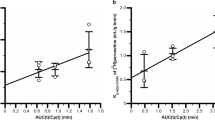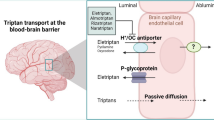Abstract
Purpose. The objective of this work was to assess, in vitro, the passage of P-glycoprotein dependent drugs across brain capillary endothelial cells, when these drugs are associated with a reversing agent.
Methods. An in vitro model of the blood-brain barrier consisting of a coculture of brain capillary endothelial cells and astrocytes was used.
Results. We demonstrate that P-glycoprotein expression is upregulated by the presence of astrocytes. Uptake in the cells and transport across endothelial cell monolayers of vincristine, cyclosporin A and doxorubicin were studied. Using S9788 or verapamil as reversing agents, we found an increase in vincristine transport across the endothelial cell monolayers. On the other hand, the association of S9788 or verapamil with cyclosporin A failed to increase the transport of this drug. An increase in the transport of doxorubicin from luminal to abluminal compartment was also observed, due to endothelial cell monolayer breakdown.
Conclusions. Using this model, it is possible to predict the passage of a P-glycoprotein dependent drug to the brain or its sequestration in brain capillary endothelial cells when this drug is associated with a reversing agent, or its toxicity on the blood-brain barrier integrity.
Similar content being viewed by others
REFERENCES
C. Boaziz, J. L. Breau, J. F. Morère and L. Israël. La barrière hémato-encéphalique: implications dans la chimiothérapie des tumeurs cérébrales. Pathologie Biologie. 39:789–795 (1991).
W. T. Cefalu and W. M. Pardridge. Restrictive transport of a lipid soluble peptide (cyclosporin) through the blood-brain barrier. J. Neurochem. 44:1954–1956 (1985).
D. J. Begley, L. K. Squires, B. Zlokovic, D. M. Mitrovic, C. C. W. Hughes, P. A. Revest, and J. Greenwood. Permeability of the blood-brain barrier to the immunosuppressive cyclic peptide cyclosporin A. J. Neurochem. 55:1222–1230 (1990).
V. A. Levin. Relationship of octanol/water partition coefficient and molecular weight to rat brain capillary permeability. J. Med. Chem. 23:682–684 (1980).
C. Cordon-Cardo, J. P. O'Brien, D. Casals, L. Rittman-Grauer, J. L. Biedler, M. R. Melamed, and J. R. Bertino. Multidrug-resistance gene (P-glycoprotein) is expressed by endothelial cells at blood-brain barrier sites. Proc. Natl. Acad. Sci. USA. 86:695–698 (1989).
A. Shirai, M. Naito, T. Tatsuta, J. Dong, K. Hanaoka, K. Mikami, T. Oh-hara, and K. Tsuruo. Transport of cyclosporin A across the brain capillary endothelial cell monolayer by P-glycoprotein. Biochim. Biophys. Acta. 1222:400–404 (1994).
A. Tsuji, T. Terasaki, Y. Takabatake, Y. Tenda, Y. Tamai, T. Yamashima, S. MOritani, T. Tsuruo, and J. Yamashita. P-glycoprotein as the drug efflux pump in primary cultured bovine brain capillary endothelial cells. Life Sci. 151:1427–1437 (1992).
T. Tatsuta, M. Naito, T. Oh-hara, I. Sugawara, and T. Tsuruo. Functional involvement of P-glycoprotein in blood-brain barrier. J. Biol. Chem. 267:20383–20391 (1992).
T. Ohnishi, I. Tamai, K. Sakanaka, A. Sakata, T. Yamashima, J. Yamashita, and A. Tsuji. In vivo and in vitro evidence for ATP-dependency of P-glycoprotein-mediated efflux of doxorubicin at the blood-brain barrier. Biochemical Pharmacology 49:1541–1544 (1995).
K. Toth, M. M. Vaughan, N. S. Peress, H. K. Slocum, and Y. M. Rustum. MDR1 P-glycoprotein is expressed by endothelial cells of newly formed capillaries in human gliomas but is not expressed in the neovasculature of other primary tumors. Am. J. Pathol. 149:853–858 (1996).
Y. Tanaka, Y. Abe, A. Tsugu, Y. Takamiya, A. Akatsuka, T. Tsuruo, H. Yamazaki, Y. Ueyama, O. Sato, N. Tamaoki, and M. Nakamura. Ultrastructural localization of P-glycoprotein on capillary endothelial cells in human gliomas. Virchows Arch. 425:133–138 (1994).
N. Drion, M. Lemaire, J. M. Lefauconnier, and J. M. Scherrmann. Role of P-glycoprotein in the blood-brain transport of colchicine and vinblastine. J. Neurochem. 67:1688–1693 (1996).
M. Lemaire, A. Bruelisauer, P. Guntz, and H. Sato. Dose-dependent brain penetration of SDZ PSC 833, a novel multidrug resistance-reversing cyclosporin, in rats. Cancer Chemother. Pharmacol. 38:481–486 (1996).
M. P. Dehouck, S. Méresse, P. Delorme, J. C. Fruchart, and R. Cecchelli. An Easier Reproducible, and Mass-Production Method to Study the Blood-Brain Barrier In Vitro. J. Neurochem. 54:1798–1801 (1990).
B. Dehouck, L. Fenart, M. P. Dehouck, A. Pierce, G. Torpier, and R. Cecchelli. A new function for the LDL receptor: transcytosis across the blood-brain barrier. J. Cell Biol. 138:877–889 (1997).
M. P. Dehouck, P. Jolliet-Riant, F. Brée, J. C. Fruchart, R. Cecchelli, and J. P. Tillement. Drug Transfer Across the Blood-Brain Barrier: Correlation Between In Vitro and In Vivo Models. J. Neurochem. 58:1790–1797 (1992).
M. P. Dehouck, B. Dehouck, C. Schluep, J. C. Fruchart, M. Lemaire, and R. Cecchelli. Drug transport to the brain: comparison between in vitro and in vivo models of the blood-brain barrier. Eur. J. Pharmaceutical Sciences. 3:357–365 (1995).
S. Méresse, M. P. Dehouck, P. Delorme, M. Bensaïd, J. P. Tauber, C. Delbart, J. C. Fruchart, and R. Cecchelli. Bovine brain endothelial cells express tight junctions and monoamine oxidase activity in long-term culture. J. Neurochem. 53:1363–1371 (1989).
J. Jetté, B. Têtu, and R. Béliveau. High levels of P-glycoprotein detected in isolated brain capillaries. Biochim. Biophys. Acta. 1150:147–154 (1993).
A. M. Julia, H. Roché, M. Berlion, C. Lucas, G. Milano, J. Robert, J. P. Bizzari, and P. Canal. Multidrug resistance circumvention by a new triazinoaminopiperidine derivative S9788 in vitro: definition of the optimal schedule and comparison with verapamil. Br. J. Cancer. 69:868–874 (1994).
B. Joly, V. Lecureur, C. Puozzo, A. Guillouzo, and O. Fardel. Involvement of P-glycoprotein in an in vitro blood-brain barrier model. Int. J. Oncol. 9:1029–1033 (1996).
T. Tatsuta, M. Naito, K. Mikami, and T. Tsuruo. Enhanced expression by the brain matrix of P-glycoprotein in brain capillary endothelial cells. Cell growth and differenciation. 5:1145–1152 (1994).
S. Cros, N. Guilbaud, M. Berlion, T. Dunn, G. Regnier, A. Dhainaut, G. Atassi, and J. P. Bizzari. In vivo evidence of a complete circumvention of vincritine resistance by a new triazinoaminopiperidine derivative S9788 in P388/VCR leukemia model. Cancer Chemother. Pharmacol. 30:491–494 (1992).
W. M. Pardridge, D. Triguero, J. Yang, and P. A. Cancilla. Comparison of in vitro and in vivo models of drug transcytosis through the blood-brain barrier. J. Pharmacol. Exp. Ther. 253:884–889 (1990).
J. A. Tumlin. Expression and function of calcineurin in the mammalian nephron: physiological roles, receptor signaling, and ion transport. Am. J. Kidney Dis. 30:884–895 (1997).
H. Ke, D. Mayrose, P. J. Belshaw, D. G. Alberg, S. L. Schreiber, Z. Y. Chang, F. A. Etzkorn, S. Ho, and C. T. Walsh. Crystal structures of cyclophilin A complexed with cyclosporin A and N-methyl-4-[(E)-2-butenyl]-4,4-dimethylthreonine cyclosporin A. Structure 2:33–44 (1994).
T. Saeki, K. Ueda, Y. Tanigawarab, R. Hori, and T. Komano. Human P-glycoprotein transports cyclosporin and FK506. J. Biol. Chem. 268:6077–6080 (1993).
K. Atkinson, J. Biggs, P. Darveniza, J. Boland, A. Concannon, and A. Dodds. Cyclosporine-associated central nervous system toxicity after allogeneic bone marrow transplantation. Transplantation 38:34–37 (1984).
T. Barbui, A. Rambaldi, L. Parenzan, M. Zucchelli, N. Perico, and G. Remuzzi. Neurological symptoms and coma associated with doxorubicin administration during chronic cyclosporin therapy. The Lancet 339: 421 (1992).
I. Tamai and A. R. Safa. Competitive interactions of cyclosporins with the vinca alkaloid-binding site of the P-glycoprotein in multidrug-resistance cells. J. Biol. Chem. 265:16509–16513 (1990).
Author information
Authors and Affiliations
Rights and permissions
About this article
Cite this article
Fenart, L., Buée-Scherrer, V., Descamps, L. et al. Inhibition of P-Glycoprotein: Rapid Assessment of Its Implication in Blood-Brain Barrier Integrity and Drug Transport to the Brain by an In Vitro Model of the Blood-Brain Barrier. Pharm Res 15, 993–1000 (1998). https://doi.org/10.1023/A:1011913723928
Issue Date:
DOI: https://doi.org/10.1023/A:1011913723928




